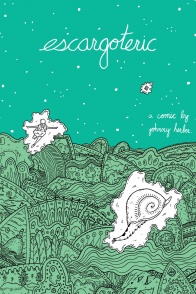“Post” and “Escargoteric” are two indie comics, each featuring a heroine in a dangerous land, because a theme never hurt anybody, but malevolent snails and acid rain just might.

Written and illustrated by Johnny Herber
Escargoteric, by Johnny Herber, is a mollusk heavy existentialist fantasy. It features snails, and a grumpy female protagonist who should know better.
Let’s take a moment to savour the phrase “mollusk heavy existentialist fantasy”.
The art style is the main draw of this comic, and I think you’ll know what I’m talking about when I say it’s the kind of book you perceive in greyscale but remember in colour. Psychedelic and surreal – and using a nice palette of greys – Johnny Herber draws a big, big, world, and populates it with sentient snails, frowning totem poles, and mystical visions.
The art is flat and textural – going particularly ham with hallucinogenic vistas – and you’re guaranteed lots of dense hatching defining repetitive details. The characterizations, in contrast, are concise but effective, relying mostly on pose, with even the snail getting across deference and regret. And all the while the layouts are dense and ambitious, keeping a clear flow but cramming a lot of action in every page.
Our heroine – Uana – is fairly straightforward, a lanky, serious type who frowns her way through the comic. Her rough circumstances have forced her to adopt an unethical trade, and she finds herself on a mission to collect an artifact. Soon, though, things get deadly, then psychedelic, then really deadly, then weird indeed.
The comic employs a nesting doll structure wherein an illusion is built, then exposed, then complicated, all within a sort of liminal afterlife-space. The big ideas at play – and the speed with which they are hashed out, then undermined – can be tricky to follow, particularly when the art is so beautifully distracting, but a squinting reread here and there will get you through.
Structural issues aside, the only thing troublesome here is the hand-lettering. The tall and skinny capital letters are sometimes CROWDEDTOOCLOSELY, making it hard to parse out the made-up fantasy words in amongst the usual ones.
The comic’s at its best when visual gags undermine an explanatory narrative voice, showing us around the “afterlife” and introducing us to its denizens. It hits a Rick and Morty stride, inviting emotional investment while piling on intellectual challenge.
All told, “Escargoteric” is a surprising read that goes all sorts of places. Here’s hoping we’ll see more of Johnny Herber’s stuff out there, mollusk-inflected or not.

Written and illustrated by Molly Brooks
Eighty years after the end of the world, a courier falls in love with a beautiful lady scientist after being hired to deliver a series of anonymous love notes to her isolated workshop.
The one’s a compact love story for all the printing-press nerds out there. Genevieve is a blacksmith in the post-apocalypse, using acid rain to etch plates and reproduce what knowledge she can find. A series of notes delivered by a mysterious courier are an unwelcome distraction, and herald some big changes.
Molly Brooks’s art is sketchy but sure – like a brisk wind is blowing through every panel – with diverse camera angles showing off a deft handling of perspective. Detail is parsed down, with emphasis placed on a few key elements in each panel, and a variety of compositions impart scope to a small page count.
All the while, the orange and blue colour palette is perfect for emphasizing the fire-and-rain world of the blacksmith, and the hand-lettering is quirky but legible.
The world-building, meanwhile, is crowded but comprehensible, and we get a solid grasp of the dangers Genevieve faces, as well as what value her work could impart, early on in the book. This information is relied incidentally, as it comes up, through dialogue.
The characterizations are probably the strongest element, sneaking up on you and delivering information before you realize it. This is particularly noticeable as an understanding (or lack thereof) develops between Genevieve and the courier, and subtle changes in posture and expression signal what complications could arise.
Continued belowThe layouts are solid and keep the story moving, but really step to the forefront during the book’s climax, warping and bubbling to imply shifts in consciousness.
Overall, the story’s charming but transparent, with the arc becoming obvious in the first half. For maximum drama, it feels like the events would need to be rearranged a little.
Like many one-shots, “Post” feels like the seed of a much bigger book, and it’s hard not to want to read that book instead. But then, that’s not the worst impression to get, and Molly Brooks feels like a creator to watch. Check out more of her work over here.






